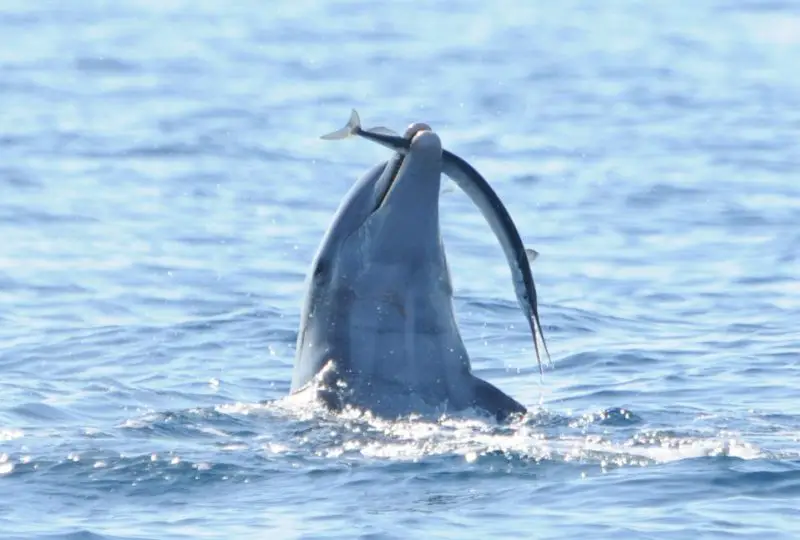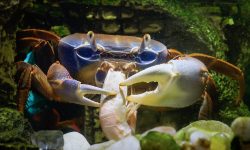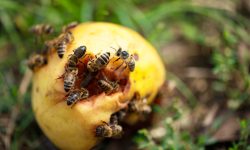Dolphins are among the most intelligent and beloved animals in the ocean. Known for their playful nature and extraordinary communication skills, these marine mammals are also expert hunters. But what exactly do dolphins eat, and how do they manage to stay so agile and powerful in the open sea?
Unlike herbivorous sea creatures, dolphins are carnivores — they rely entirely on meat to survive. Their diet consists mostly of fish, squid, and crustaceans, though what they eat can vary depending on their species and habitat. From the tropical waters of the Caribbean to the cold seas near the Arctic, dolphins adapt their feeding habits to whatever prey is most abundant.
In this article, we’ll explore 20 foods dolphins love the most, uncovering how each meal helps keep them healthy, strong, and fast — perfectly suited for life as one of the ocean’s top predators.
Understanding the Dolphin Diet

Dolphins as Marine Carnivores
All dolphin species are carnivorous, meaning their entire diet comes from other animals. However, their food preferences differ widely between species. Bottlenose dolphins, for instance, favor fish and squid, while orcas — the largest members of the dolphin family — can eat seals, penguins, and even sharks.
Their diets reflect the ecosystems they inhabit. Coastal dolphins usually hunt small schooling fish near shorelines, while offshore dolphins dive deeper for squid or deep-sea fish.
How Dolphins Hunt
Dolphins are among the most skilled hunters in the animal kingdom. They hunt using echolocation, emitting high-pitched clicks that bounce off nearby objects and return as echoes, revealing the size, shape, and distance of their prey.
They often hunt in groups, working cooperatively to herd fish into tight clusters called “bait balls.” This teamwork ensures every member gets a share. In other cases, dolphins may slap their tails on the water to stun prey or chase fish toward the shore for easy capture.
Feeding Behavior and Adaptation
A dolphin’s diet changes based on region, season, and available prey. In warm tropical waters, fish and squid dominate the menu, while in colder regions, they may rely more on crustaceans or even small marine mammals.
Their ability to adapt their hunting strategies and diet makes dolphins some of the most successful marine predators on Earth.
20 Foods Dolphins Love the Most
1. Fish
Fish form the bulk of most dolphins’ diets. They eat species such as mackerel, herring, sardines, and mullet, depending on what’s available in their environment.
Fish provide vital protein and fat, giving dolphins the energy they need for swimming long distances and performing acrobatic jumps. Dolphins swallow fish whole, head first, to avoid scales or fins sticking in their throats.
Hunting fish also serves a social function, strengthening bonds among pod members who work together to trap schools of prey.
2. Squid
Squid are a favorite food, especially for deep-sea and offshore dolphins like the spinner and dusky dolphin. They’re soft, rich in protein, and easy to digest.
Many squid species glow in the dark, making them easier for dolphins to detect during nighttime hunts. Dolphins use echolocation to pinpoint them, often swallowing them whole in a single gulp.
For dolphins living in the open ocean, squid provides a crucial food source when fish are scarce.
3. Crustaceans
Shrimp, prawns, and small crabs are part of the diet for dolphins living in estuaries or shallow coastal zones. These crustaceans are rich in calcium and minerals essential for bone strength and nerve function.
Dolphins dig through sandy bottoms or chase crustaceans hiding in coral reefs. Some species use bursts of air bubbles to dislodge them.
Though smaller than fish or squid, crustaceans offer a nutritious, easily accessible food source.
4. Octopus
Octopus are a prized but tricky meal for dolphins due to their strength and ability to cling with tentacles. To avoid getting entangled, dolphins shake or toss octopus against the water before eating.
Octopus meat is rich in protein, fat, and trace elements that support muscle and brain function. Dolphins usually target small to medium-sized species.
Their problem-solving approach to eating octopus demonstrates their remarkable intelligence.
5. Anchovies
Anchovies are small, oily fish packed with omega-3 fatty acids and protein. Dolphins often hunt them in massive schools, using coordination to herd them tightly before feeding.
These fish are easy to swallow and provide instant energy. Coastal dolphins, particularly in temperate waters, rely heavily on anchovy populations.
Anchovies are also an important indicator species — when their numbers decline, dolphin behavior and migration patterns often shift.
6. Mackerel
Mackerel are a high-energy food source that provides fat and protein, ideal for dolphins that travel long distances. Their oily flesh gives sustained energy for active swimming.
Dolphins catch mackerel in groups, circling schools from below and driving them upward to the surface.
This food is especially important for larger species like bottlenose and common dolphins.
7. Sardines
Sardines are another schooling fish that dolphins love. They’re rich in essential nutrients and easy to catch in large numbers.
Dolphins use cooperative hunting to drive sardines into tight balls, then take turns diving in to feed. This feeding frenzy often attracts seabirds and larger fish to the scene.
Sardines’ high fat content helps dolphins maintain body warmth in cooler waters.
8. Herring
Herring are one of the top dietary staples for dolphins in northern oceans. These fish travel in large shoals, making them perfect prey for group-hunting dolphins.
Rich in protein and healthy fats, herring supports the high energy demands of cold-water dolphins.
Feeding on herring also provides hydration, as the fish’s moisture content keeps dolphins from needing to drink seawater.
9. Eels
Eels are slippery but nutritious prey. Their elongated bodies provide a dense source of protein and healthy oils.
Dolphins may chase eels into rocks or coral crevices and use their snouts to flush them out.
Eels are especially favored by dolphins living in estuaries and river mouths where these fish are abundant.
10. Small Sharks
Large dolphins, especially orcas (killer whales), sometimes hunt small sharks or rays. These powerful predators use teamwork to disable or flip sharks upside down, inducing temporary paralysis.
Shark meat provides high-quality protein and fat. However, this prey requires skill and cooperation to capture.
Only larger dolphin species attempt this, showcasing their strength and advanced hunting intelligence.
11. Lanternfish
Lanternfish are small, deep-sea fish that emit light, making them visible in dark waters. Deep-diving dolphins like the dusky and spinner species often feed on them.
Their high-fat content provides essential energy for deep dives where oxygen is limited.
Lanternfish are also a vital part of the oceanic food chain, linking smaller plankton to larger predators like dolphins.
12. Shrimp
Shrimp are a favorite among coastal dolphins. They live in shallow water and are easy to catch in large quantities.
Shrimp offer high protein, calcium, and trace minerals like zinc and magnesium. Dolphins often use sonar to detect shrimp buried in the sand.
For young dolphins learning to hunt, shrimp serve as ideal training prey because of their size and abundance.
13. Crabs
Small crabs are eaten by dolphins that forage along sandy seabeds. They use their snouts to flip rocks or disturb sediment, revealing hidden crustaceans.
Crabs are packed with nutrients like protein, calcium, and phosphorus, all vital for maintaining muscle tone and bone health.
Though harder to catch than shrimp, crabs make a rewarding meal, especially for estuarine and river-dwelling dolphins.
14. Cephalopods (General)
Beyond squid and octopus, dolphins also eat other cephalopods such as cuttlefish. These creatures are rich in protein and minerals and are relatively easy to digest.
Dolphins use echolocation to detect cephalopods hiding in sand or hovering midwater.
Cephalopods make up a large part of many deep-sea dolphins’ diets, especially where fish are scarce.
15. Jellyfish
Although jellyfish are not a major food source, some dolphins will nibble on them if other prey is limited.
They tend to eat the soft parts and avoid the stinging tentacles. Jellyfish offer moisture and trace minerals but minimal energy.
Occasional jellyfish consumption shows how dolphins adapt when typical food sources are unavailable.
16. Squat Lobsters
These small crustaceans live on rocky seabeds and are a nutritious supplement for dolphins in coastal regions.
Squat lobsters are rich in calcium and provide a crunchy texture that helps clean dolphins’ teeth.
They demonstrate the variety in a dolphin’s diet — a balance of both soft-bodied and hard-shelled prey.
17. Flying Fish
Flying fish, which leap above the ocean surface, are sometimes caught midair by fast-swimming dolphins.
These fish are rich in omega-3 fats, perfect for energy and cardiovascular health.
The chase provides both exercise and entertainment for playful dolphins, who often compete for airborne prey.
18. Cuttlefish
Cuttlefish are soft, nutrient-dense cephalopods that many dolphin species enjoy. They contain calcium, protein, and essential amino acids.
Cuttlefish are easily caught thanks to their slower movement, making them a staple in deep-water dolphin diets.
Their ink sacs sometimes burst during capture, but this doesn’t deter dolphins — they continue to feed confidently.
19. Sea Snails
In coastal habitats, dolphins occasionally consume sea snails. They crush the shells to reach the soft inner flesh.
Sea snails are rich in protein and provide trace minerals like selenium and iodine.
Though not a regular food, they add diversity to the dolphin’s omnivorous seafood menu.
20. Tuna
Tuna are strong, fast fish — and only the largest dolphins, like orcas, are capable of catching them. Working in coordinated pods, they surround schools of tuna and take turns attacking.
Tuna provide enormous nutritional value with protein, iron, and essential fats. They help sustain large dolphin species in colder waters.
This type of high-energy hunting underscores dolphins’ status as apex predators of the marine world.
Frequently Asked Questions (FAQs)
Are dolphins carnivores?
Yes. Dolphins are strict carnivores — they eat fish, squid, crustaceans, and sometimes other marine mammals.
Do dolphins chew their food?
No. Dolphins swallow their food whole. Their conical teeth are used to grip and hold prey, not to chew.
How often do dolphins eat?
Dolphins eat multiple times a day, consuming 4–6% of their body weight daily, depending on their activity and species.
Do dolphins drink seawater?
No. Dolphins get most of their hydration from the moisture in their food, especially fish and squid.
Do all dolphins eat the same food?
No. Diets vary by species and region. For example, river dolphins eat more crustaceans and small fish, while oceanic dolphins eat squid and pelagic fish.
Conclusion
Dolphins are extraordinary hunters — intelligent, cooperative, and perfectly adapted to their oceanic world. From tiny shrimp to large tuna, their diet reflects not only what’s available in their environment but also their advanced hunting strategies.
Each meal provides essential nutrients for strength, agility, and brain function, allowing dolphins to remain some of the most remarkable predators in the sea.
Understanding what dolphins eat reveals much about their behavior, intelligence, and ecological importance. These graceful mammals remind us that every bite they take — from fish to squid — plays a vital role in maintaining the delicate balance of marine life.






